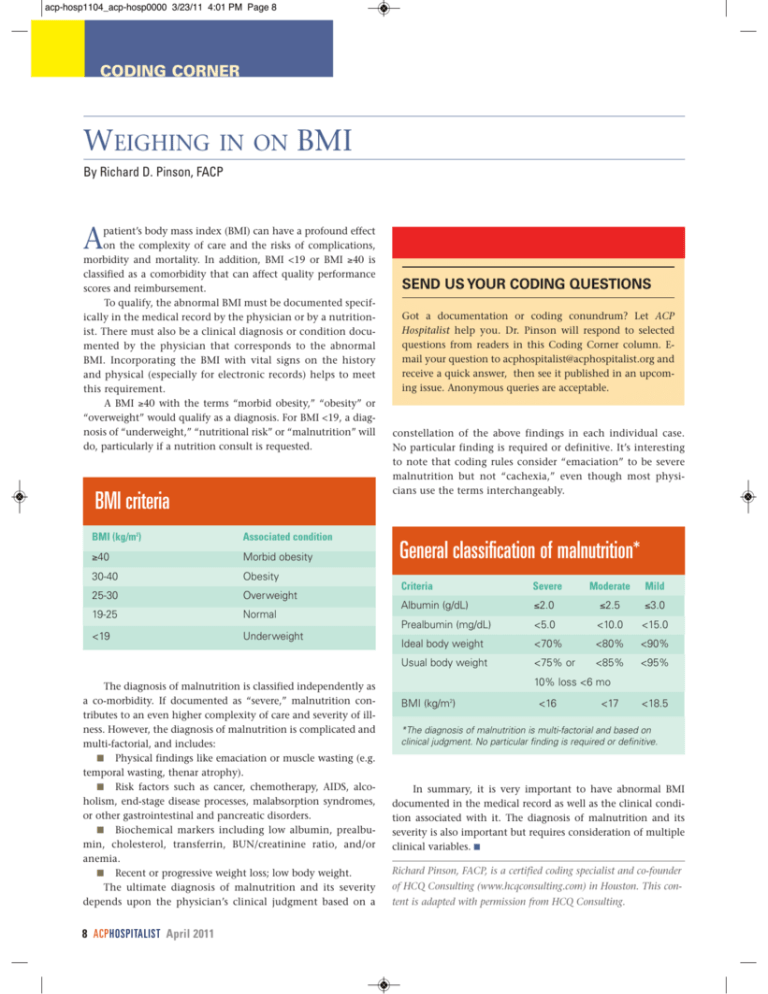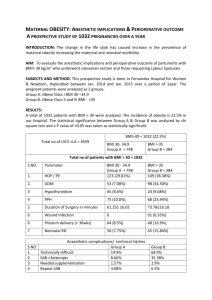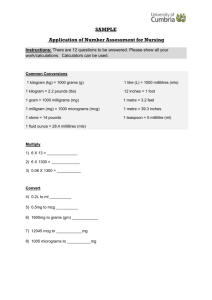General classification of malnutrition
advertisement

acp-hosp1104_acp-hosp0000 3/23/11 4:01 PM Page 8 CODING CORNER WEIGHING IN ON BMI By Richard D. Pinson, FACP A patient’s body mass index (BMI) can have a profound effect on the complexity of care and the risks of complications, morbidity and mortality. In addition, BMI <19 or BMI ≥40 is classified as a comorbidity that can affect quality performance scores and reimbursement. To qualify, the abnormal BMI must be documented specifically in the medical record by the physician or by a nutritionist. There must also be a clinical diagnosis or condition documented by the physician that corresponds to the abnormal BMI. Incorporating the BMI with vital signs on the history and physical (especially for electronic records) helps to meet this requirement. A BMI ≥40 with the terms “morbid obesity,” “obesity” or “overweight” would qualify as a diagnosis. For BMI <19, a diagnosis of “underweight,” “nutritional risk” or “malnutrition” will do, particularly if a nutrition consult is requested. BMI criteria BMI (kg/m2) Associated condition ≥40 Morbid obesity 30-40 Obesity 25-30 Overweight 19-25 Normal <19 Underweight The diagnosis of malnutrition is classified independently as a co-morbidity. If documented as “severe,” malnutrition contributes to an even higher complexity of care and severity of illness. However, the diagnosis of malnutrition is complicated and multi-factorial, and includes: ■ Physical findings like emaciation or muscle wasting (e.g. temporal wasting, thenar atrophy). ■ Risk factors such as cancer, chemotherapy, AIDS, alcoholism, end-stage disease processes, malabsorption syndromes, or other gastrointestinal and pancreatic disorders. ■ Biochemical markers including low albumin, prealbumin, cholesterol, transferrin, BUN/creatinine ratio, and/or anemia. ■ Recent or progressive weight loss; low body weight. The ultimate diagnosis of malnutrition and its severity depends upon the physician’s clinical judgment based on a 8 ACPHOSPITALIST April 2011 SEND US YOUR CODING QUESTIONS Got a documentation or coding conundrum? Let ACP Hospitalist help you. Dr. Pinson will respond to selected questions from readers in this Coding Corner column. Email your question to acphospitalist@acphospitalist.org and receive a quick answer, then see it published in an upcoming issue. Anonymous queries are acceptable. constellation of the above findings in each individual case. No particular finding is required or definitive. It’s interesting to note that coding rules consider “emaciation” to be severe malnutrition but not “cachexia,” even though most physicians use the terms interchangeably. General classification of malnutrition* Criteria Severe Moderate Mild Albumin (g/dL) ≤2.0 ≤2.5 ≤3.0 Prealbumin (mg/dL) <5.0 <10.0 <15.0 Ideal body weight <70% <80% <90% Usual body weight <75% or <85% <95% 10% loss <6 mo BMI (kg/m ) 2 <16 <17 <18.5 *The diagnosis of malnutrition is multi-factorial and based on clinical judgment. No particular finding is required or definitive. In summary, it is very important to have abnormal BMI documented in the medical record as well as the clinical condition associated with it. The diagnosis of malnutrition and its severity is also important but requires consideration of multiple clinical variables. g Richard Pinson, FACP, is a certified coding specialist and co-founder of HCQ Consulting (www.hcqconsulting.com) in Houston. This content is adapted with permission from HCQ Consulting.







